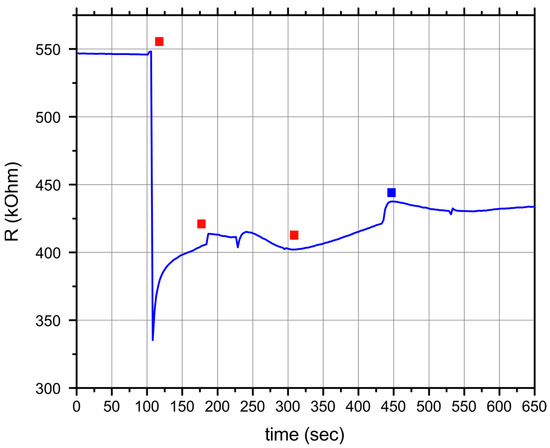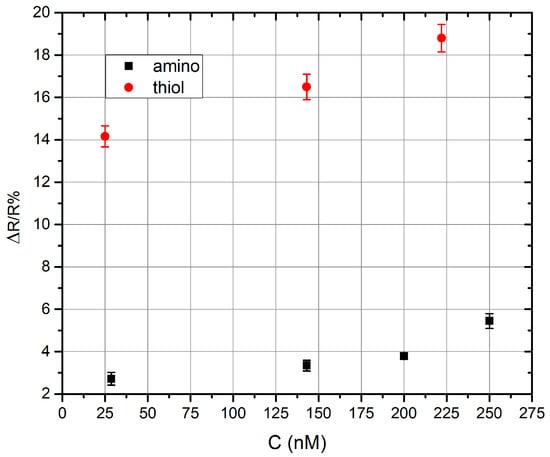Abstract
In this work, a biosensor for heavy metal-ion detection, based on platinum nanoparticles (Pt NPs) and DNAzymes, is presented. Two chemical modification groups were utilized for the DNAzymes’ immobilization on the Pt NPs film. The biosensors were characterized concerning their ability to detect Lead (Pb2+) ions in buffer solutions. Both immobilization techniques exhibit great sensitivity with a detection limit of 25 nM.
1. Introduction
Heavy metal ions, such as lead (Pb), chromium (Cr), cadmium (Cd), etc., present a serious environmental threat when found in soil and water; thus, their accurate and fast detection poses a major challenge. Although several detection methods have been proposed in the literature [1], they are expensive and time-consuming. In this work, we present a biosensing device for heavy-metal ion detection based on Pt NPs and DNAzymes [2]. The biosensors feature two distinctive DNAzymes species with different chemical modification groups (i.e., thiol- and amino-modified), that enable their attachment on the Pt NP layer. Both immobilization techniques can detect ion consecrations of 25 nM but with different relative resistance change responses.
2. Materials and Methods
All devices are fabricated on silicon substrates with a 300 nm thermal SiO2 layer. Gold interdigitated electrodes, 50 nm thick, have been patterned on SiO2 film via optical lithography with an inter-finger electrode gap of 10 μm. Electron gun thermal evaporation was used to deposit the gold electrodes with 10 nm Ti as an adhesion layer. After the fabrication of the electrodes, Pt NPs were deposited between the electrodes, using a modified DC magnetron sputtering system. The deposited nanoparticles have a mean diameter of 4 nm and a surface coverage of 49%, which is right below the percolation threshold of the system. The surface coverage of the Pt NPs film prevents the creation of continuous conductive paths from one electrode to another, forming an NP film that acts as nano-gapped electrodes. Due to the film’s surface coverage and the formation of inter-particle gaps, the current that flows through the conductive paths travels from one nanoparticle to the next via the tunneling effect. The overall resistance of these devices is about hundreds of kOhms.
After the Pt NP deposition follows the DNAzymes functionalization. Two distinctive DNAzymes species with different chemical modification groups have been used. The first method uses amino-modified DNAzymes, while in the second method, thiol-modified DNAzymes were employed. For the amino-modified DNA immobilization technique, the following steps have been applied. The first step involves the SiO2 surface activation with oxygen plasma, then the surfaces were functionalized with (3-Aminopropyl)triethoxysilane (APTES), an aminosilane aimed for the process of silanization, implying the functionalization of surfaces with alkoxysilane molecules. This is essential for the next step of the process, where the covalent bond between glutaraldehyde with the alkoxysilane molecules is established. Specifically, the linking occurred between the silane amines and the carbonyl groups of glutaraldehyde. Once the surface is functionalized, the process is followed by probe immobilization and target hybridization steps. Initially, ssDNA substrate probes become covalently bonded with the other carbonyl groups of glutaraldehyde. After covalent coupling, the remaining reactive groups should be blocked to avoid covalent binding of the DNA strands. Therefore, the remaining activated carboxylic groups (those not bonded with the substrate DNA sequences) are blocked with ethanolamine. The final step of the whole process involves the hybridization of the DNAzyme sequences with the immobilized substrate strands. In the finalized device, the DNAzymes are immobilized on vacant spots on the SiO2 surface (Figure 1a). For the thiol-modified DNA immobilization technique, there is no need for surface modification prior to probe immobilization and target hybridization. Therefore, ssDNA substrate probes are initially deposited on the Pt NPs via drop-casting, then methylcyclohexane (MCH) is employed to convey the same blocking effect as ethanolamine on the amino-modified DNA sequences. Finally, the DNAzyme sequences are hybridized with the immobilized substrate strands. The resulting devices have the DNAzymes immobilized directly on Pt NPs (Figure 1b).

Figure 1.
Schematic representation of the functionalized surfaces with (a) amino-modified DNAzyme and (b) thiol-modified DNAzyme.
The bio-sensing devices were characterized by measuring changes in resistance using a Keithley 2400 multimeter, under a 1 V bias. As a first step, the buffer solution was drop-casted on top of the biosensors (represented in Figure 2 with red rectangles); this step was repeated until device resistance became immune to further buffer addition. After the buffer-stabilization steps, a buffer solution containing a known heavy-metal ion concentration was drop-casted on the sensor (represented in Figure 2 with blue rectangles), resulting in an increase in device resistance following the mechanism discussed in previous publications by this group [2,3]. The DNAzymes react with the heavy metal ions resulting in their collapse from double-stranded to single-stranded DNA. The double-strand DNA exhibits higher conductivity than the single-strand DNA, therefore the biosensor’s resistance increases in the presence of heavy metal ions. The biggest difference between the 2 different biomolecule immobilization protocols is where the biomolecules bind. In the case of the amino-modified DNAzymes, the biomolecules bind on top of the SiO2 surface and, in the second, directly onto the Pt NPs.

Figure 2.
This figure shows an amino-modified DNAzymes biosensor’s resistance over time. Red rectangles represent when the buffer was drop-casted over the sensor, while blue represents the target (Pb2+) addition. The concentration of the Pb2+ was 143 nM and the ΔR/R% was 3.3%.
3. Results
Figure 3 compares the sensitivity of the two different DNAzymes for varying Pb2+ concentrations. Both techniques present a linear response range, for maximum concentrations of 225 nM and 250 nM in the case of thiol and amino-modified DNAzymes, respectively. The devices also exhibit a low limit of detection (LoD) of 25 nM, in agreement with the permitted levels of Pb2+ for the EU [4]. Finally, thiol-modified DNAzymes showcase higher sensitivity when compared to amino-modified DNAzymes; this can be related to the variations between the two chemical modifications and the quality of their attachment on the NP layer. As discussed previously, the basic difference between the two categories of biosensors lies in the immobilization protocol. The amino-modified DNAzymes are functionalized in such a way as to bind with the uncovered SiO2 substrate, therefore, they will fill the gaps that interrupt the conductive paths. When they are double-stranded they allow the passage of electrons during their transition from one nanoparticle to another, while when they are single-stranded they become less conductive and reduce the possibility of the tunnel effect occurring. However, although the sensors can detect very small concentrations, as shown in Figure 3, their response is low since the DNAzymes can only affect the conductivity of the device by changing the surrounding medium of the NP layer. On the other hand, the thiol-modified DNAzymes bind directly onto the Pt NPs. Therefore, as the electrons pass from one electrode to the other, they can pass through the double-stranded DNA to cross the gaps interrupting the conductive paths. When in the presence of heavy metal ions, the double-stranded DNA becomes single-stranded hence an increase in resistance will occur. At the same time, the probability for charge transport via the tunneling effect will decrease, just as in the case of amino-modified DNAzymes.

Figure 3.
Relative resistance changes of different Pb2+ concentrations for the two immobilization techniques. Error bars represent device-to-device deviation for 5 devices in each category.
4. Conclusions
In the present work, a highly sensitive heavy-metal ion sensor based on Pt NPs and DNAzymes was presented. For the DNAzyme immobilization step, two different binding methods were used (amino-modified DNAzymes and thiol-modified DNAzymes); this resulted in biosensors with high sensitivity and a low detection limit. In conclusion, sensors functionalized with thiol-modified DNAzymes outperformed in terms of sensitivity amino–modified based sensors while at the same time, they offer simpler and faster fabrication.
Author Contributions
Conceptualization, E.S. and G.T. (George Tsekenis); methodology, E.S. and G.T. (George Tsekenis); investigation, C.P. and A.R.; data curation, C.P., A.R. and G.T. (Georgia Tzourmana); writing—original draft preparation, E.A. and E.S.; writing—review and editing, E.S.; visualization, C.P. and E.A.; supervision, E.A., E.S. and D.T.; project administration, D.T.; funding acquisition, E.S., G.T. (George Tsekenis), and D.T. All authors have read and agreed to the published version of the manuscript.
Funding
This research has been co-financed by the European Regional Development Fund of the European Union and Greek national funds through the Operational Program Competitiveness, Entrepreneurship, and Innovation, under the call RESEARCH-CREATE-INNOVATE (project code: T2EDK-02144).
Institutional Review Board Statement
Not applicable.
Informed Consent Statement
Not applicable.
Data Availability Statement
The data presented in this study are available on request from the corresponding author.
Conflicts of Interest
The authors declare no conflict of interest.
References
- Zhang, Y.; Yavari, K.; Wang, Y.; Van Cappellen, P.; Liu, J. Deployment of functional DNA-based biosensors for environmental water analysis. Trends Anal. Chem. 2022, 153, 116639. [Google Scholar]
- Skotadis, E.; Tsekenis, G.; Chatzipetrou, M.; Zergioti, I.; Tsoukalas, D. Heavy metal ion detection using DNAzyme-modified platinum nanoparticle networks. Sens. Actuators B Chem. 2017, 239, 962–969. [Google Scholar]
- Skotadis, E.; Voutyras, K.; Chatzipetrou, M.; Tsekenis, G.; Patsiouras, L.; Madianos, L.; Chatzandroulis, S.; Ioanna, Z.; Tsoukalas, D. Label-free DNA biosensor based on resistance change of platinum nanoparticles assemblies. Biosens. Bioelectron. 2016, 81, 388–394. [Google Scholar]
- European Parliament, Council of the European Union. Directive (EU) 2020/2184 of the European Parliament and of the Council of 16 December 2020, on the quality of water intended for human consumption. Off. J. Eur. Union 2020, 435, 1–62. [Google Scholar]
Disclaimer/Publisher’s Note: The statements, opinions and data contained in all publications are solely those of the individual author(s) and contributor(s) and not of MDPI and/or the editor(s). MDPI and/or the editor(s) disclaim responsibility for any injury to people or property resulting from any ideas, methods, instructions or products referred to in the content. |
© 2023 by the authors. Licensee MDPI, Basel, Switzerland. This article is an open access article distributed under the terms and conditions of the Creative Commons Attribution (CC BY) license (https://creativecommons.org/licenses/by/4.0/).